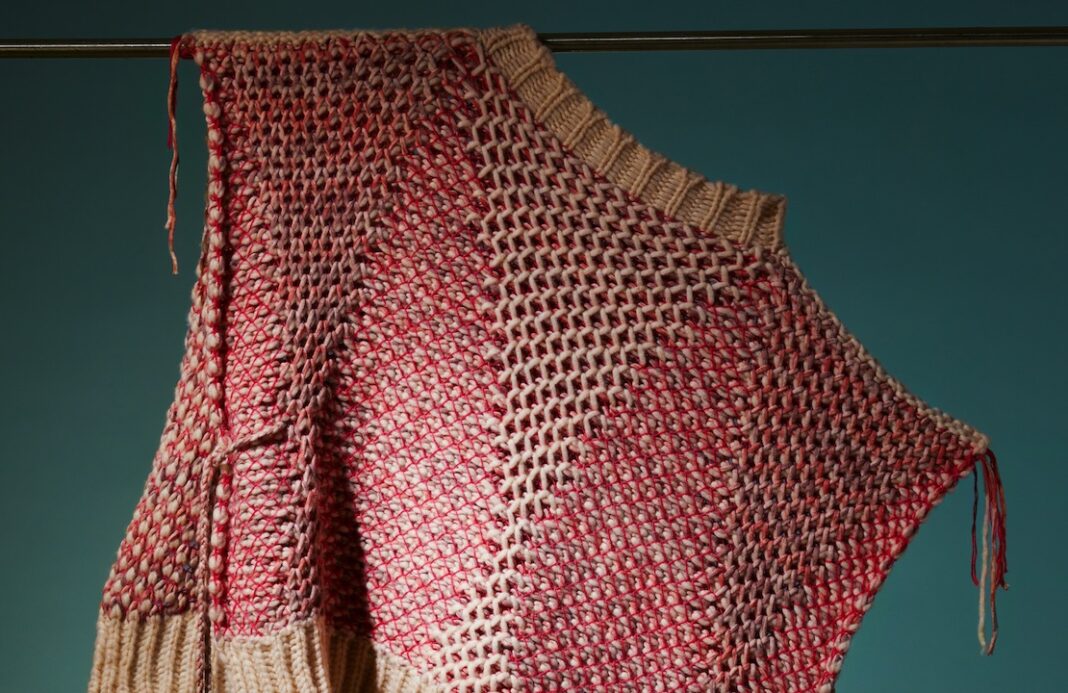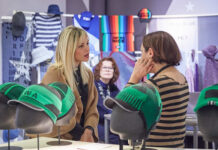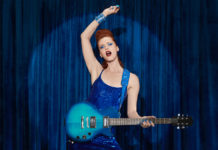London
Knitwear designer Beth Ranson reviews Jörg Hartmann and Anna Gitelson-Kahn’s new book.
Published in June 2023, ‘Color in Knitting: By Designers, for Designers’ was written by Karl Mayer Stoll’s Head of Fashion & Technology Jörg Hartmann and Anna Gitelson-Kahn, Associate Professor at Rhode Island School of Design. The aim of the publication is to provide a resource for designers of varied backgrounds to engage with colour techniques for knitting, opening their eyes to the colourful possibilities that knitting can hold.
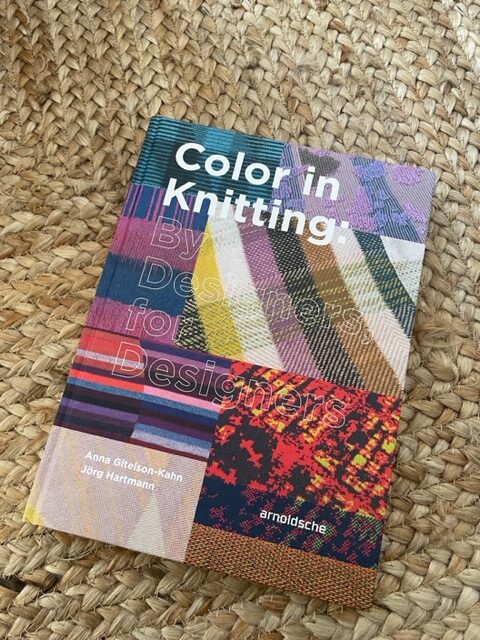
Those new to knitting can easily become locked into stripe settings as their main vehicle for colour changes, given this naturally occurs when changing colour/yarn between courses of the carriage. It is only with practice and experience that knitters discover the possibilities held within the countless variations of colour work that hand knit, hand-flat and power machine knitting has to offer. ‘Color in Knitting: By Designers, for Designers’ is a visual collection of imagery which does not gatekeep. Beautifully photographed Stoll knitted fabrics are labelled with the technical names for their techniques, inviting both inspiration and education around these terms. What this book does so well is to offer a visual and technical introduction to the wide-ranging possibilities of colour use within Stoll knitting. Ranging across colour palettes and hues, yarns and stitch structures, the imagery within the book truly is exciting.
The complexities of translating sketchbook research and mood-boards into knitted fabrics
For designers and within many undergraduate design courses, the first point of visual reference for a creative project is photography, mixed media drawing and filling sketchbooks with creative responses to research. For print and embroidery designers the translation of colour, line and form from sketchbook pages onto fabrics can be more literal than for knitters. For knitters, paper designs and drawings cannot necessarily translate directly to a knitted fabric. Further adaptations and abstractions are required in order to emulate the paper aesthetic within knitted structures. This can result in a disappointing watering down of aesthetic once realised in knitted form. For designers to truly succeed, they need to understand the possibilities open to them – and indeed- how to push those possibilities to their limits too.
Many students and designers do not have direct studio access to Stoll and power machine knitting technology. This can limit knowledge on the possibilities that knitted textiles have to offer. This book offers tangible insight to what power machine knitting and particularly Stoll technology can offer, making it a great tool for educating around this topic.
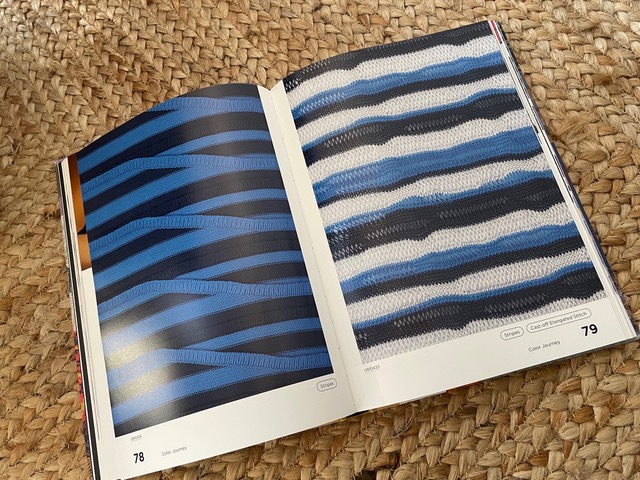
Equipping readers with technical vocabulary
Naturally, the person designing is rarely an engineer or technician – nor the engineer/technician doing the designing. For this reason, knitting and particularly power machine knitting can feel daunting to those who are more accustomed to working with creative freedom at their own hand flat machines or knitting needles. Power knitting machines can therefore feel limiting and daunting to approach, and lack of technical language can be a communication barrier between designers and technicians.
Another thing this book does well is to welcome designers and makers to a visual collection of the possibilities that Stoll machinery and technology opens up to them. Without over-complicating things, it offers imagery AND technical vocabulary, inviting curiosity and opportunities to learn more. So often knitters may be inspired by a fabric they see but may not be able to work out exactly what stitch structure has been applied to achieve it.
This publication does not hold back. In part 1‘Colour journey’ high resolution images are labelled with their combined techniques. Though technical language is used, it is not overwhelming. Over 90 pages of imagery materials are contained here, depicting a huge variety of colour applications. Not only inspiring for colour palettes but also colour blending and colour context – how a stitch can change the appearance of colours and combinations of colour.
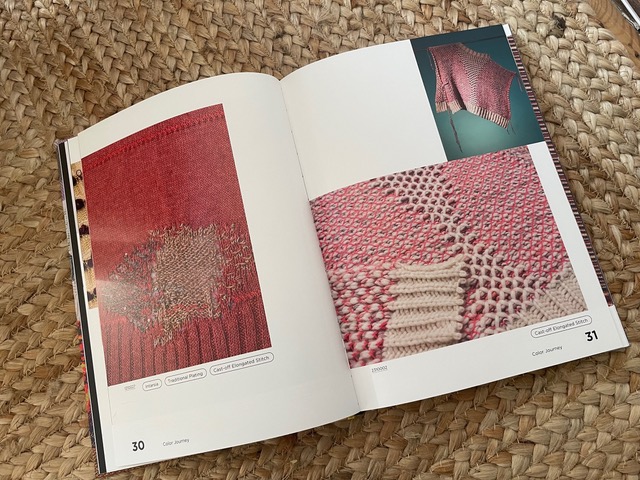
Types of colour application in Stoll knitting
The authors’ quote “Stripes are the simplest way to combine colors in knit” is indeed true, but this simplicity can feel like a curse for designers who are fighting to disguise and blend colour changes in more subtle ways. The book explores the beauty held within combining colour changing rows with varied stitch structures such as half-cardigan and Milano rib, creating almost optical illusions and breaking away from the traditional stripe format.
Intarsia and independent colour effects are also explained, discussing the localised use of yarn feeders. Given intarsia is traditionally a hand knitting method, for those new to power machine knitting technology this information forms connections between craft and technology methods. The combination of intarsia with jacquard and pointelle techniques is also introduced to readers, exemplifying again the way in which this book urges designers to be playful, push perceived limitations and make their own textures and patterns as unique as possible.
Stitch diagrams and technical vocabulary are utilised throughout the book in a gentle, informative way. Technical planning of designs is also touched upon, for example where colour fields versus amount of yarn feeders are discussed in regards to Intarsia design. Again, this is information that many students and knitters new to the field of power machine knitting may not have realised was an important consideration.
The boundaries of the techniques contained in the book are well explained, but the potential to work around these, problem solve and push them is also celebrated and encouraged too. This really can be the true joy of knitting – translating creative ideas into fabrics that emulate aesthetics, whilst paying attention to details and technical ability.
A resource for students
At under-graduate level where access to Stoll machinery may well be limited to a few hours per week, per student, preparation for these sessions is essential. Students need to have their art works ready to translate into their fabrics with the support of their technician.
One of the challenges for students new to this is understanding the various types of knitted jacquard structures and the limitations/ potential that each of these methods holds for them and their designs. This book would certainly serve as a useful resource to these students in preparing their artworks ready to translate to stitch lay outs. Float, Stripe, Twill, Cross-tubular, Net and Relief jacquards are thoroughly explained within the publication- a truly invaluable material source for anyone learning about jacquard structures (alongside the many other techniques included too).
A small detail, but important not to overlook, is the detailed glossary at the back of the book. This again is a simple yet effective resource for readers to brush up on their technical vocabulary.
Similarly, for new designers or those paying for machine time with technicians at a Stoll design studio, this book would be beneficial in providing the tools to make the most of booked time. When working on the clock for paid resources, this can be a pressure on creative minds who are working out how best to explain their ideas to a technician. Utilising the information in the book would help designers to translate their ideas with clarity in a time efficient manner and ensure their knitted outcomes are as expected.

Further publications of this nature would be enthusiastically welcomed, helping to bridge the gap in understanding to empower designers to take on more challenging power-knitting projects and structures. This is certainly a book that educational institutions should stock in their libraries to encourage student access, and one which designers from many creative backgrounds could benefit from engaging with.
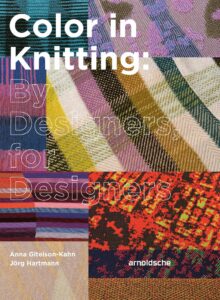
The book was published in collaboration with Arnoldsche Verlagsanstalt GmbH and can be purchased by following this link.
Further resources
Color in Knitting collection by Stoll

Subscribe To Our Newsletter
Join our mailing list to receive the latest news and updates from our team.


